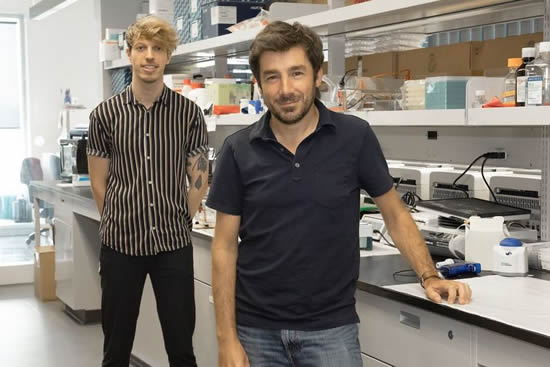HIV Reservoirs Are Established Earlier Than Expected
02/28/2023

Pierre Gantner and Nicolas Chomont
For the first time in humans, a research team has shown that, as early as the first days of infection, HIV is able to create reservoirs where it will hide and persist during antiretroviral therapy.
Until now, the scientific community did not know exactly when or how these viral reservoirs—the existence of which is a major obstacle to curing HIV—are established in human beings.
In a study published in the journal Immunity, scientists led by Nicolas Chomont, a researcher at the CHUM Research Centre (CRCHUM) and professor at Université de Montréal, found that a small fraction of the virus integrates into the genome of CD4+ T cells in the very first weeks of infection (the acute phase), but does not replicate there. It therefore escapes the notice of the fastest diagnostic tool to date, which detects active viral replication.
CD4+ T cells are HIV’s primary targets. They are white blood cells responsible for activating the human body’s defence against infections.
“With the help of an analysis technique developed in our laboratory, we were able to observe and count the T cells infected by the virus in human samples collected in the earliest stages of the infection,” said Chomont, the study’s principal author. “We succeeded in detecting the presence of the virus through sequencing even when it was hidden in cells that weren’t participating in viral replication.”
To study these initial phases of the spread of the virus, Pierre Gantner, a former postdoctoral student in Chomont’s lab and the study’s first author, had access to samples of blood and inguinal lymph node tissue from 25 people in the first acute-infection cohort of the U.S. Military HIV Research Program in Thailand.
This cohort, RV254/SEARCH010, was launched more than 10 years ago in collaboration with the Thai Red Cross AIDS Research Centre and has enrolled nearly 800 volunteers. Chomont and his team have been closely cooperating with their colleagues in Thailand since its launch.
Mapping the types of infected cells
Through their analysis technique, the CRCHUM scientists succeeded in counting the CD4+ T cells infected by the virus during the acute phase of the infection.
These infected cells increased in number from 10 to 1,000 per million CD4+ T cells in less than seven days, thereby showing the extreme speed with which HIV spreads.
The scientists also observed that the characteristics of the cells targeted by HIV in the first weeks of the infection varied quickly and differed depending on whether they were located in the blood or lymph nodes.
“For example, we noticed that few Tfh—T follicular helper cells—are infected by the virus during the acute phase of the infection,” said Chomont. “Since they play a crucial role in viral replication, the scientific community thought that they were the first to be infected.”
“In fact, we counted a lot more [infected Tfh] during the chronic phase of the disease, which is about two months after infection. At that point, they are actively contributing to the development of the disease.”
Until now, these types of studies have been carried out on animal models. Therefore, this is the first time that the early stages of the infection in humans have been described so precisely.
Destabilizing the reservoirs
A large part of global research dedicated to the study of HIV focuses on how to reactivate the virus lying dormant in the reservoirs in order to neutralize it.
“’The earlier we start antiretroviral therapy, the more we prevent the virus from replicating and the more we limit the size of the reservoirs. We proved that in 2020,“ said Chomont.
“However, it seems clear that early antiretroviral therapy should be combined with another treatment to force the virus out of its hiding places, because at the time of diagnosis latent reservoirs will have already been established in people infected with HIV.”
In collaboration with scientists from the United States, Chomont’s research team is currently evaluating whether this type of treatment administered in the acute infection phase would prevent the establishment of viral reservoirs.
About this study
“HIV rapidly targets a diverse pool of CD4+ T cells to establish productive and latent infections” by Pierre Gantner et al., was published online Feb. 17, 2023, in Immunity.
The study was funded by the U.S. Military HIV Research Program, Walter Reed Army Institute of Research; the Foundation for AIDS Research (amfAR Research Consortium on HIV Eradication); the Canadian Institutes of Health Research; the Canadian HIV Cure Enterprise (CanCURE); the AIDS and Infectious Diseases Network of the Fonds de Recherche du Québec-Santé; the Thai Red Cross Research Center; and, in part, the U.S. National Institutes of Health (NIH).
Contact
Jeff Heinrich
jeff.heinrich@umontreal.ca
Université de Montréal
Tel: 514 343-7593
Source: https://nouvelles.umontreal.ca/en/article/2023/02/28/hiv-reservoirs-are-established-earlier-than-expected/
"Reproduced with permission - " Université de Montréal "
the Université de Montréal
For more HIV and AIDS News visit...
Positively Positive - Living with HIV/AIDS:
HIV/AIDS News |